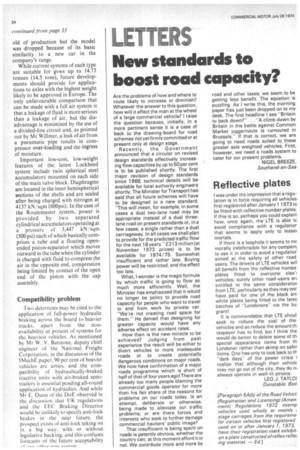New standards to boost road capacity?
Page 40

If you've noticed an error in this article please click here to report it so we can fix it.
Are the problems of how and where to route likely to increase or diminish? Whatever the answer to this question, how will it affect the man at the wheel of a large commercial vehicle? I raise the question because, initially, in a more pertinent sense it is a case of back to the drawing-board for road schemes not yet firmly committed or at present only at design stage.
Recently, the Government announced that a circular on revised design standards effectively increasing flow capacities by up to 50 per cent is to be published shortly. The first major revision of design standards since 1968; technical details will be available for local authority engineers shortly. The Minister for Transport has said that all future schemes will have to be designed to a new standard. "This will mean, for example, in some cases a dual two-lane road may be appropriate instead of a dual threelane road on present standards or, in a few cases, a single rather than a dual carriageway. In all cases we shall plan to provide for the predicted traffic flow for the next 18 years." £213 million (at November 1973 prices) is to be available for 1974/75. Somewhat insufficient and rather late. Buying power will be restricted, and the effect too late.
What, I wonder is the magic formula by which traffic is going to flow so much more efficiently. Well, the Minister has emphasized that it wbuld no longer be policy to provide road capacity for people who want to travel to and from work by private car. "We're not creating road space for them." He denied that designing for greater capacity would have any adverse effect on accident rates.
How then is the new miracle to be achieved? Judging from past experience the result will be either to divert vehicles to more inadequate roads or to create potentially dangerous conditions on major roads. We now have confirmation of a major roads programme which is short of half of that of four years ago! There are already too many people blaming the commercial goods operator for more than his fair share of the reasons for problems on our roads today. Is an attempt, deliberate, or otherwise, being made to alleviate our traffic problems; or are there forces and interests who seek to further damage commercial hauliers' public image?
That insufficient is being spent on roads is patently obvious, whether the country can, at this moment afford it or not. We contribute more and more by road and other taxes; we seem to be getting less benefit. The equation is puzzling. As I write this, the morning paper has just been dropped on to my desk. The first headline I see "Britain to back down?" ... "A climb-down by Britain in the battle against Common Market juggernauts is rumoured in Brussels." If that is correct, we are going to need roads suited to these greater axle weighted vehicles. First, however, we need a roads system to cater for our present problems.
NIGEL BREEZE, Southend-on-Sea
Reflective plates
I was under the impression that a regulation is in force requiring all vehicles first registered afterJanuary 11973 to be fitted with reflective number plates. If this is so, perhaps you could explain how, once again, the LTE is able tc avoid compliance with a regulatior that seems to apply only to lessei mortals.
If there is a loophole it seems to ME morally indefensible for any comparn to use it in order to avoid a regulatior aimed at the safety of other road users. The drivers of LTE vehicles wit all benefit from the reflective numbe plates fitted to everyone else': vehicles; surely other road-users an entitled to the same consideratioi from LTE, particularly as they may wel have paid for one of the black an white plates being fitted to the lates batches of "Londoners" via the bu grant!
It is commendable that LTE shout seek to reduce the cost of the' vehicles and so reduce the amount th taxpayer has to find, but I think the would do better to delete some of th special appearance items from th Londoner rather than skimp on safel items. One has only to look back to th "dark days" of the power crisis 1 realize that although their vehicIE may not go out of the city, they do ni always operate in well-lit streets. LEO J. TAYLOI °unstable, Bed [Paragraph 5A(b) of the Road Vehict (Registration and Licensing) (Amen, ment) Regulations 1972 exetnp vehicles used wholly or mainly stage carriages from the requireme for certain vehicles first registered used on or after January 1, 1973, have their registration mark exhibit. on a plate constructed of reflex relief ing material. — Ed.]
































































































